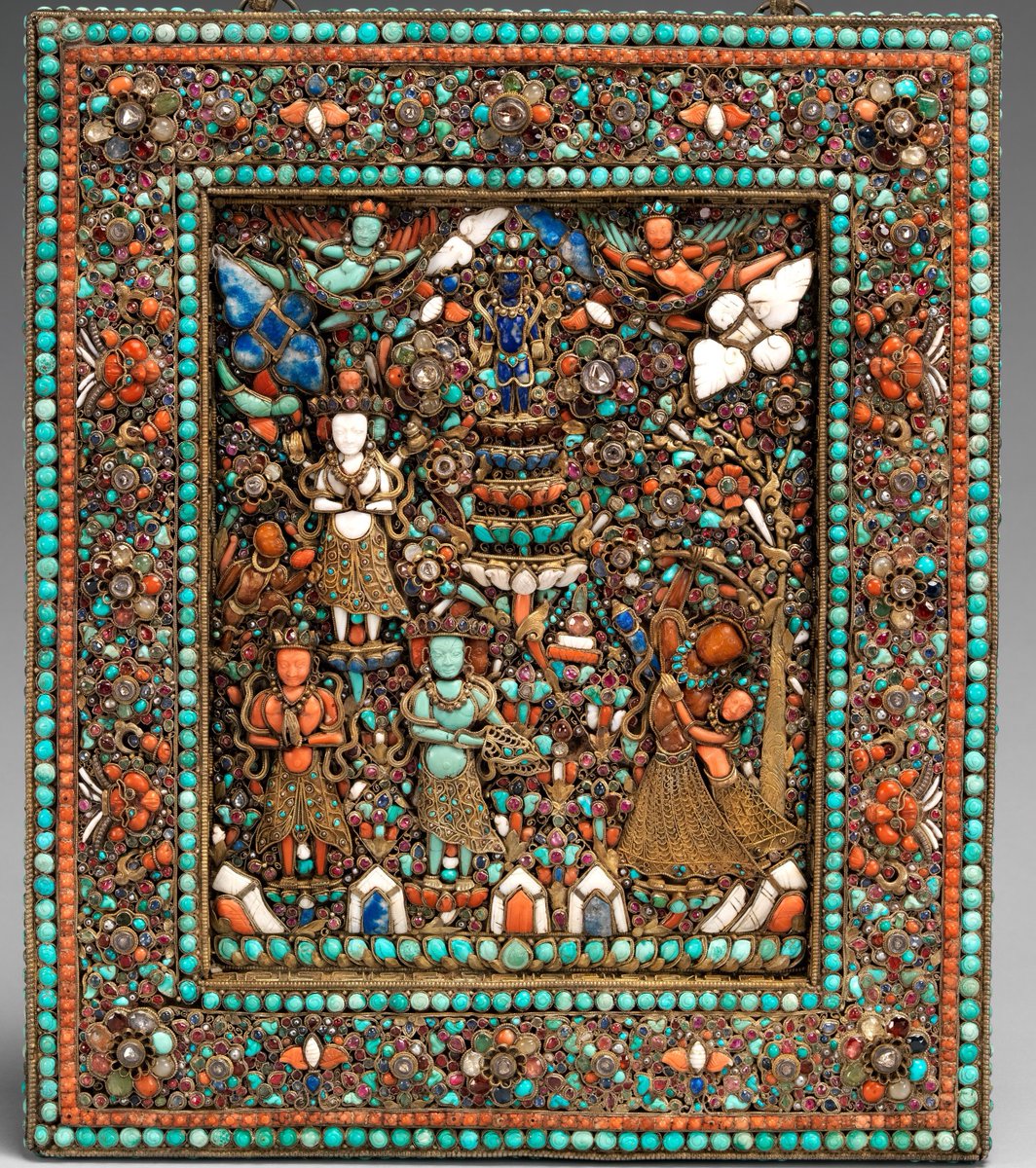
Today, the Buddha’s birthday is celebrated in Japan. I previously did a #buddhistart thread on the Buddha's death. Let’s do a birthday one now. 1/ 

The birth of the Buddha is said to be miraculous. He was born from his mother’s right side, rather than vaginally. His birth can be seen in this image from the Cleveland Museum of Art from northeastern India. I love Indra catching him! 2/ clevelandart.org/art/1959.349 

This one from the Met from a few centuries later is similar. He is both born from the side and then reappears a second time standing on flower petals to receive his first bath. 3/
metmuseum.org/art/collection…
metmuseum.org/art/collection…

An 18th–19th c. image from Nepal similarly depicts the birth and bathing, but it does so with a stunning mosaic of precious stones including diamonds, rubies, emeralds, sapphires, and more. 💎💎💎4/
metmuseum.org/art/collection…
metmuseum.org/art/collection…

The scene was also painted. This banner and the next from Dunhuang in western China narrate the miraculous birth, followed by his bath and seven steps, after which he pointed to the sky and declared “I alone am honored.” 5/ britishmuseum.org/collection/obj… 

The pose of the Buddha pointing to the sky after he took seven steps and made his famous declaration appears in the second banner from Dunhuang continued from above. The pose of the hand pointing upwards became standard. 6/
britishmuseum.org/collection/obj…
britishmuseum.org/collection/obj…

We can see this pose and a narrative scene in this wonderful Japanese painting from the Met too, which is viewed from right to left and narrates the whole birth. 7/
metmuseum.org/art/collection…
metmuseum.org/art/collection…

Many relatively early statues from seventh-century and eighth-century Japan follow this same pose. The most famous is this one from Tōdaiji, a national treasure. This image includes a basin used to bathe the Buddha, recreating the scene from his birth. 8/ 

While that is the most famous example, there are many others, suggesting that bathing the birthday Buddha was a popular practice going back to seventh-century Japan (and earlier elsewhere). This image from Harvard is an early Japanese example. 9/
hvrd.art/o/70150
hvrd.art/o/70150

The tradition of bathing the Buddha continued to be practiced in future centuries and was also long the subject of Japanese art. Here are two 18th-century woodblock prints from the MFA. He is bathed by dragons. 10/
collections.mfa.org/search/objects…

collections.mfa.org/search/objects…


The famous pose that we saw earlier with the finger in the air was even painted with Kabuki actors. In this version, the actor Matsumoto Kōshirō VI strikes the pose, as depicted by Utagawa Kuniyoshi. 11/ collections.mfa.org/objects/461425… 

This is reminiscent of the death scenes featuring famous actors that I discussed in my earlier thread. 12/
https://twitter.com/bryandaniellowe/status/1493599697252106255
(And as an aside, perhaps Matsumoto Kōshirō VI had some resemblance to the Buddha, because here he appears again as Buddha from Zenkōji temple taming a catfish associated with earthquakes). 13/ collections.mfa.org/objects/461522… 

Anyway, back to bathing the Buddha. Bathing the Buddha isn’t just an artistic representation. It’s also a practice that continues today. People will often poor sweet tea over images of the Buddha to bathe him, as you can see in this video. 14/
It’s also depicted in popular culture, like this scene of Brahma with a super soaker of sweet tea aiming it at the Buddha's urna or third eye in the comic Saint Young Men about Buddha and Jesus as roommates in modern Japan. 15/ 

Beyond bathing with tea, I also learned from Twitter today that it seems a lot of people eat curry to celebrate the Buddha's birthday, presumably because of the connection to India. This seems to be a pretty recent tradition. 16/
https://twitter.com/mihotoke_chan/status/1512227557458194432
Not onto curry? I see a lot of people making birthday Buddha pancakes with a clever play on words of hot cake (pancakes, pronounced hottokēki) and hotoke or the word for Buddha. 17/
https://twitter.com/usagitv/status/1511855768215031810
But there are all sorts of ways to celebrate. You can even get this snow globe, which I very much want! I guess I'll have to wait for my birthday next March! 18/
https://twitter.com/handa_camera/status/1512210052064890881
Or you can stage a party with Sylvanian Family (Calico Critters), cake, curry, and ET in a Buddha birthday pose! 19/
https://twitter.com/sikisokuzeQoooo/status/1512083121155743752
Happy birthday Buddha (at least for those following the Gregorian calendar like they do in Japan)! 20/20
These closeups better illustrate the scenes I mentioned in the 15th-century Japanese painting from the Met. I love how he is basically coming out of her sleeve! Also, note the seven lotuses for each of his first seven steps.
https://twitter.com/nocontextbuddha/status/1512420033737244673
Have to add these two fun examples of birthday Buddha's to the thread. 😍😍😍
https://twitter.com/isumubutuzouc/status/1512443963080601605
• • •
Missing some Tweet in this thread? You can try to
force a refresh





